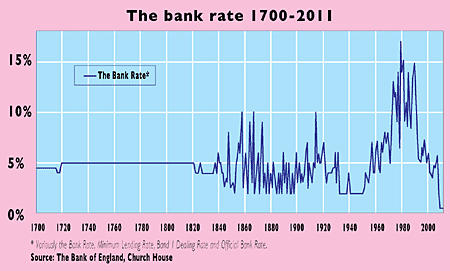
I have a soft spot for Church House Investment Management. That’s because they were the first to send me my favourite chart – the one of the UK base rate going back to 1698. I’ve written about it here before. But, for those who missed it, the chart shows that, over the last 300-odd years, the base rate has never been as low as it is now and, at 0.5%, it is a quarter of its previous low (2%).
I now take this chart with me everywhere I go. If you have seen me speak anywhere in the last 18 months, you should have a picture of it stuck in your head. I also still advise everyone to have a copy of it stuck above their desk. Why? So that every time someone tells them that everything is fine, or that we can force growth, or that house prices have bottomed, they can look at it and remind themselves that we remain in a state of financial emergency.
When people see the chart, their most commonly asked question is how long will the base rate stay this low? I can’t answer that exactly (obviously!).
However, I can say that, while it might not stay at 0.5%, it will certainly stay below inflation for years. Why? Because negative real interest rates – rates held below the level of inflation – are the easiest, most obvious way for a social democracy to deal with debt.
Anyone in any doubt that populations can be forced to put up with this for long periods needs only look to history for proof: the average real interest rate on deposits across advanced economies from 1945 to 1980 was -1.94%. That means that, after taking into account inflation, anyone who kept their money in cash throughout the 35-year period would have lost 2% a year, every year, and seen the purchasing power of their cash more or less cut in half.
We’ve been suffering under similar conditions in the UK for three years now. But, given that we have barely started dealing with our debt, we can expect to be stuck with them for many years to come.
With this in mind – and the fact that, at some point I am going to have to move properly out of cash and into real assets – I was pleased to hear from Church House again this week. It has just launched a new fund, the Deep Value Investments Fund, to be run by Jeroen Bos – and I rather like the idea of it.
I interviewed Bos in July last year when he was hoping to launch the fund as an investment trust. That didn’t work out (not the best time to raise money for a closed-end fund that doesn’t have the words China, frontier or emerging market in its headline). So now he is having a go at it as a unit trust.
Bos isn’t new to ‘deep value’ investing. He’s been running a small offshore fund since 2003 which has followed the same strategy he is planning for the new fund. That means only buying stocks trading below their net working capital (their very liquid assets minus their debt) – the idea being that, if the companies he holds shut down tomorrow, he would still clear more from their fire sales than he pays for them.
However, that isn’t enough. Before he buys, Bos also likes to see that there might be a catalyst for change in the nearish future and wants to be convinced that the management hasn’t given up on finding it. Investing like this also means having pretty intense convictions. Bos has identified a mere 500-600 companies around the world (14 in the UK at the moment) that meet his high (or low – depending how you look at it) standards, and he intends to only hold 30 or so in his portfolio.
He says the idea is to be research-dependent, disciplined, patient and – most importantly – “absolute return orientated”. His main aim is not to lose your money.
That seems like a useful goal, and he seems to have done a good job so far: the offshore fund is up nearly 60% since December 2003 (the FTSE All Share is up 35% over the same period).
Church House’s original investment trust was going to carry a performance fee. However, I’m pleased to say that this fund doesn’t – even if its management fee, at 1.25%, isn’t as low as I would like.
If you are interested in value investing, the other fund I like and wrote about here last year is the Kennox Strategic Value Fund. As is the case with Church House, I think Kennox really mean it when they say they are only interested in capital preservation and value.
They’re long term, they’re global and, while the last few months haven’t been brilliant, they appear to be making their strategies work: they launched in the UK in 2009, since then the fund has risen 33% (the MSCI World Index is up about 9%).
Clearly, three years isn’t long enough to tell us that Kennox is really getting it right. But add it to their investment process – looking for good quality low-debt companies of which the market has low expectations – and I hope it gives us something of a hint.
• This article was first published in the Financial Times.